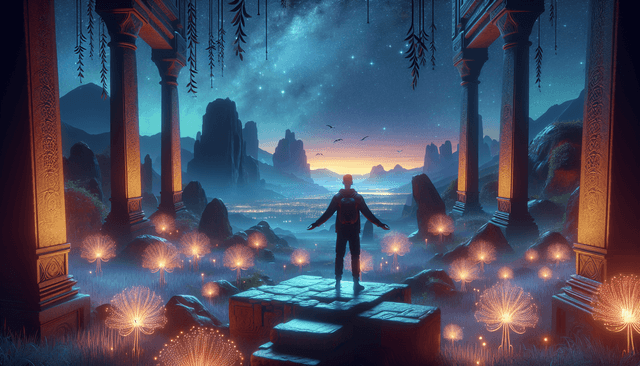Table of Contents
Creating a fantasy world can feel overwhelming. You might wonder how to make it rich and engaging without getting lost in endless details or complicated rules. It’s totally normal to feel a bit daunted by the idea of crafting a universe that feels both alive and believable.
But don’t worry! By sticking around, you’ll discover some handy tips that will help you build a cohesive and captivating fantasy world without it becoming a chore. You’ll find ways to weave magic, culture, and character into the fabric of your story, making everything come together beautifully.
Get ready to explore essential techniques! From developing a unique magic system to balancing simplicity with depth, these tips will spark your imagination and guide you through the exciting process of worldbuilding.
Key Takeaways
Stefan’s Audio Takeaway
- Have a clear vision of your world’s geography, history, and cultures to create a cohesive setting.
- Design a strong magic system with clear rules and consequences to enhance tension and engagement.
- Develop distinct cultures with unique customs, languages, and histories to add depth to your narrative.
- Ensure internal logic governs your world’s elements for consistency and immersion.
- Integrate worldbuilding with character development to enhance the emotional connection.
- Balance detail and simplicity, offering key information gradually to avoid overwhelming readers.
- Utilize dialogue and action to reveal world details organically, keeping the story flowing.
- Draw inspiration from real-world cultures and history to avoid clichés and add authenticity.
- Establish reader expectations early on to enhance engagement with your fantasy world.
- Avoid overplanning your world; leave room for organic storytelling and character growth.

Create a Cohesive Fantasy World
Building a cohesive fantasy world starts with a clear vision of its geography, history, and cultures.
Map out your world and ensure locations are well-defined—think about geographical features like mountains, rivers, and forests.
While a character might journey across a 1000-mile landscape, remember that realistic travel speeds should be considered; establishing a belief in your world is vital.
Start with broad strokes, then fill in the details; for example, if you have an empire, give it a capital city, smaller towns, and noticeable landmarks.
This helps create a sense of place and belonging.
Take inspiration from various cultures, perhaps merging elements from different real-world societies.
By doing so, you give your world depth and authenticity, making it feel alive to your readers.
Develop a Strong Magic System
A magic system can be one of the most captivating elements of your world, if crafted carefully.
The trick is to set clear rules and limitations to keep your readers engaged and to maintain tension.
You might want to outline what each magical ability entails—who can wield it and under what circumstances.
Consider a balance between power and consequence; magic shouldn’t solve all problems instantly.
For instance, if a character uses magic to heal, what cost might they incur—energy depletion, aging, or maybe a spell that consumes another’s life force?
This kind of depth will draw your readers deeper into your world.
You could also create unique artifacts or locations that enhance or limit magic, adding variety and intrigue to your spells.
Craft Detailed Cultures and Societies
Cultures and societies add layers to your story, making your world feel rich and diverse.
Start by brainstorming the various cultures that exist in your world, ideally 5-7 to keep things manageable.
Each culture should have its own customs, languages, beliefs, and historical events that shape their identity.
This can mean developing unique holidays, traditional clothing, culinary specialties, or even distinct moral viewpoints.
For example, if one society values trade and commerce, while another worships nature, their interactions will be complex.
Create distinct languages or dialects for your cultures; even a few phrases can bring authenticity.
Wrap it up by thinking about how these societies interrelate—are they in conflict, trade partners, or entirely isolated?
This web of connections makes your world sound real and alive to the reader.

Establish Internal Logic for Your World
Creating a believable fantasy world relies on establishing strong internal logic that governs its rules and systems.
This includes understanding how magic works, how societies interact, and why characters behave as they do.
Define the laws of physics in your world; for instance, if your characters can fly, what are the limitations of that ability?
Every component should interact cohesively; if a character has magic, how does that influence societal structures or economies?
Consistency in these elements lets readers suspend disbelief, making your world more immersive.
It’s essential to ensure that the implications of your decisions are reflected consistently throughout your narrative.
This internal coherence fosters a more engaging story, as readers can grasp your universe’s complexities and rules.
Integrate Worldbuilding with Characters
Fusing worldbuilding with character development is key to crafting a rich narrative.
Consider how your characters’ backgrounds shape their perspectives and actions within the world.
A character from a war-torn land will have different motivations compared to someone raised in a peaceful society.
Make your characters’ choices influenced by the world around them; if they live in a harsh environment, their resilience is likely heightened.
It’s also helpful to reveal details of your world through character interactions and dialogue.
Instead of lengthy exposition, allow experiences to unfold naturally, making the world feel lived in.
When characters grapple with their environment, readers connect more deeply to both the characters and the setting.
Balance Detail and Simplicity in Your Story
Finding the balance between providing intricate details and keeping the story accessible is crucial.
Too much detail can overwhelm readers, while too little can fail to pull them into your world.
Focus on the elements that are essential to your plot and character development.
Incorporate details gradually as they enhance the narrative or deepen character relationships.
Chunk your worldbuilding into bite-sized pieces; for example, sprinkle cultural practices and background information throughout dialogue instead of cramming it into a single chapter.
This method keeps the pacing dynamic and allows readers to digest information comfortably.
Ultimately, aim for a clear and captivating story that draws readers in without drowning them in exposition.
Use Dialogue and Action for Subtle Worldbuilding
Dialogue and action are invaluable tools for worldbuilding, allowing you to showcase your setting organically.
Instead of narrating information, let characters reveal their world through natural conversation.
A discussion about local customs can expose cultural nuances without feeling forced.
Moreover, actions can convey societal norms; a character’s reaction to a traditional celebration illustrates their cultural background.
Utilize character quirks and interactions to hint at historical events that shape the current state of your world.
This strategy keeps the focus on the story while subtly enriching the background.
When done right, readers will absorb the world’s intricacies like they’re learning about a friend’s life—enjoyably and unintrusively.
Draw Inspiration from Real World and Existing Concepts
Real-world cultures, histories, and ideas can serve as rich sources of inspiration for your fantasy world.
Research various cultures to find unique aspects to incorporate into your societies, creating authenticity.
You can also look at historical events and legends to craft compelling backstories and conflicts.
Take a unique tradition from one culture and merge it with an imaginary one to create fresh elements.
Don’t hesitate to borrow concepts from mythology; a mythical creature can add depth to your world.
This approach can spark creativity while ensuring your world doesn’t feel cliché or superficial.
Ultimately, blending the old with the new can lead to a captivating tapestry of elements that intrigue and inspire readers.
Set Reader Expectations Early in Your Story
Establishing clear expectations for the world at the beginning of your story helps readers navigate the narrative.
Use the first few chapters to introduce essential elements like magic systems, cultures, and political structures.
Let readers know what to expect regarding tone, pacing, and the types of challenges characters will face.
You can use shocking events or unique customs to create intrigue and prompt questions that keep readers turning pages.
By doing this, you enable your audience to invest in the characters and their journeys within this newly defined world.
Keeping consistency with these early clues creates a more immersive experience throughout the unfolding story.
Avoid Overplanning Your Worldbuilding
While worldbuilding is essential, overplanning can lead to creative paralysis or a lack of spontaneity in your story.
Leave space for organic growth; sometimes, the best ideas come from characters reacting to unexpected situations.
Start with a clear framework but allow your world to evolve as your story unfolds.
You might discover new cultures or details as your characters interact, enriching your narrative without feeling forced.
Consider keeping a separate document with ideas and inspirations instead of fully fleshing everything out initially.
This approach helps keep your world dynamic and relatable, as it evolves alongside your characters.
Embrace the messiness of creativity; this flexibility often leads to the most satisfying storytelling experiences.
FAQs
To create a cohesive fantasy world, develop a consistent set of rules, geography, and history. Ensure all elements align with your chosen themes and keep cultural, societal, and magical aspects unified throughout your narrative.
A strong magic system should have clear rules, limitations, and consequences. This adds depth and realism. Consider how magic affects society, and ensure it serves to enhance character development and plot tension.
Focus on essential details that enrich the story. Avoid overwhelming readers with excessive information. Use character perspectives to reveal world elements naturally and maintain clarity while providing enough context for immersion.
Integrate worldbuilding with character development by making cultural, societal, and personal background influences on characters’ actions. Use dialogue, motivations, and conflicts that arise from the world’s context to deepen both character arcs and setting understanding.



